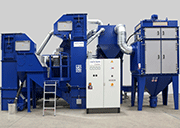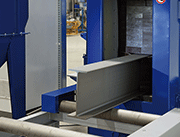E-Archive
Articles
in Vol. 14 - November Issue - Year 2013
Automatic Blasting Is Also Sensible For Smaller Companies

Overview of the AGTOS Ocean Blaster. To the left, the work piece intake; in the middle, the blasting chamber with adjacent modules; to the right, the outlet sluice and the cartridge filter unit.

The outlet side of the AGTOS Ocean Blaster with a perfectly blasted carrier
After a need for blasting machines was indicated for smaller factories in the steel industry, AGTOS reacted by developing a machine that fulfils this need. The goal was to develop a roller conveyor shot-blasting system for operators that have halls often with low ceilings. The "Ocean-Blaster" fulfils this and other additional requirements.
The Ocean Blaster is a very compact roller conveyor shot-blasting machine for smaller factories for which a turbine wheel shot-blasting machine was not profitable due to the capacity. From now on, these users can profit from the advantages of the AGTOS blasting technology. An in-house blasting system allows for more flexible, independent operation and transport channels, and costs are not incurred. The work pieces to be processed can be up to 1000 mm high and 500 mm wide.
The AGTOS engineers have designed the Ocean Blaster to be much more compact than other commercial machines. It was thus possible to generate space advantages. Even the height of the system is extremely low at 4.1 meters. Thus, the machines can also be used in smaller production halls without a foundation. In addition, the machine is designed to be operator-friendly. A maintenance platform allows quick access to the wind sifter; appropriately dimensioned maintenance openings ensure easy access to wear and tear parts in case of maintenance.
Decisive advantages
Prior to starting the blasting process, using the rotating potentiometer, the operator sets the feed speed which corresponds to the degree of impurity, respective to the desired degree of cleaning for the work pieces. For processing surfaces that are to have a purity grade of BSa 2.5 after the blasting process, the flow-through speed is generally approx. 1.0 m per minute when using round-grain abrasives.
An additional aspect of the design was energy efficiency. The powerful AGTOS high-performance turbines with increased abrasive throughput thanks to the one-disc technology and the cartridge filtration system with differential pressure-independent cleaning of the filter cartridges, offer concrete advantages. As a result, the Ocean Blaster consumes a comparatively low amount of energy and abrasives in comparison to other commercial systems. Thus, the operating costs are kept low.
To keep the height of the blasting machine low, the bucket elevator was separated into two parts. The first part cleans the abrasive. The second part is responsible for supplying the abrasive to the high-powered turbines.
So the wear and tear costs are kept low, while a work-piece tracking system on the intake of the blasting machine ensures that abrasives are only introduced to the turbines if a work piece is in the blasting area. When the fully-cleaned part has passed the blasting area and no more work pieces have been fed into the blasting chamber, this is detected, the abrasive supply is closed, and the second part of the abrasive circuit is shut off with the turbines.
If no additional work piece is detected at the intake light barrier within 15 minutes, the first part of the abrasive circuit shuts off. For an additional blasting process, the system must be restarted by pressing the button.
After the work pieces run through the blasting zone, they go to the blow-off system, which is also activated by the slide register. A high-pressure bellows supplies air nozzles that are aligned so they blow off residual abrasive from the work piece surfaces and feed it back into the abrasive circuit. The outlet sluice, in accordance with the intake side, has several rows of sealing blades. The discharge of stray blasting grains is thus reliably prevented. In the case of servicing, these blades are replaced in only a few steps.
This and other advantages allow economic processing of the work pieces.
For Information:
AGTOS
Gesellschaft für technische
OberfläYhensysteme GmbH
Gutenbergstr. 14
48282 Emsdetten, Germany
Tel. +49.2572.96026-0
E-mail: info@agtos.de
www.agtos.de



























